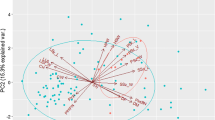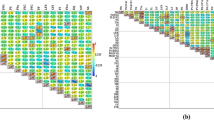Abstract
Genetic diversity in Musa species (AAB genome) has been collected and conserved in several germplasm banks in different parts of the world. However, not many of these collections contain dichotomous branching accessions which display an incredible amount of phenotypic polymorphisms, arising from the presence of different forms of floral clusters that result in the production of multiple bunches at fruiting. In spite of their fascinating attraction and seductive appeal, the agronomic implications of these genetic resources have been grossly understudied. This investigation, therefore, redresses some of these limitations in knowledge through evaluation of the occurrence and persistence of inflorescence dichotomy during three production cycles in field plots. All inflorescence dichotomous cultivars had a concordance coefficient of less than 100%. Data derived from Poisson distribution further confirmed the randomness of occurrence and non-persistence of the polymorphisms as phenotype reversals was frequently detected, implying that multiple-bunching is a random and unstable genetic trait in plantain. Multivariate data analysis used to classify the plantains demonstrated significant (p ≤ 0.05) differences in agro-morphological traits. Furthermore, the major discriminating traits between and within the cultivars appraised from factor analysis were four yield-related principal components including number of fingers per hand, fingers per bunch, hands per bunch and bunches per plant, which accounted for 73.035% of total variability across all cultivars; that together with firmness of pulp and pulp to peel ratio of the fruits, were the traits of overriding economic and horticultural significance. Collectively, the data presented here provide new paradigms indicating that these yield-related traits could serve as markers for understanding the field performance of inflorescence dichotomous plantain cultivars, which can be used as critical genetic resources for future improvement of this economically important crop.


Similar content being viewed by others
References
Agoreyo BO, Golden KD, Brown SE (2008) Analysis of genetic variability among plantain cultivars (Musa paradisiaca L.) using arbitrarily primed PCR technique. Afr J Biotechnol 7:1041–1045
Amah D, Alamu E, Adesokan M, van Biljon A, Maziya-Dixon B, Swennen R, Labuschagne M (2019) Variability of carotenoids in a Musa germplasm collection and implications for provitamin A biofortification. Food Chem X 2:100024
Bello-Pérez LA, De Franscisco A, Acevado-Agama E, Gutierrez-Meraz F, Garcia-Suarez FJL (2005) Morphological and molecular studies of banana starch. Food Sci Tech Int 11:367–372. https://doi.org/10.1177/1082013205058409
Blomme G, Ploetz R, Jones D, De Langhe E, Price N, Gold C, Geering A, Viljoen A, Karamura D, Pillay M, Tinzaara W, Teycheney P-Y, Lepoint P, Karamura E, Buddenhagen I (2013) A historical overview of the appearance and spread of Musa pests and pathogens on the African continent: highlighting the importance of clean Musa planting materials and quarantine measures. Ann Appl Biol 162:4–26
Brisibe EA, Ekanem NG (2019) Ploidy level and nucleotide variations in inflorescence dichotomous cultivars of Musa species (AAB genome). BMC Genomics 20:713. https://doi.org/10.1186/s12864-019-6083-5
Brisibe EA, Ubi GM (2020) Microsatellite fingerprinting and analysis of intra-population divergence in morphotaxonomic traits in a large Musa (AAB genome) germplasm. Physiol Mol Biol Plants 26:1973–1988. https://doi.org/10.1007/s12298-020-00877-0
Brown A, Tumuhimbise R, Amah D, Uwimana B, Nyine M, Mduma H, Talengera D, Karamura D, Kuriba J, Swennen R (2017) Bananas and plantains (Musa spp.). In: Campos H, Caligari PD (eds) Genetic improvement of tropical crops. Springer, Basel, pp 219–240
Christelová P, De Langhe E, Hribova E, Cizková J, Sardos J, Hušáková M, Van Den Houwe I, Sutanto A, Kepler AK, Swennen R, Roux N, Dolezel J (2017) Molecular and cytological characterization of the global Musa germplasm collection provides insights into the treasure of banana diversity. Biodivers Conserv 26:801–824. https://doi.org/10.1007/s10531-016-1273-9
Crouch JH, Vulysteke D, Oritz R (1998) Perspectives on the application of biotechnology to assist the genetic enhancement of plantain and banana (Musa spp). Electron J Biotechnol 1:1–18
Ekanem NG, Brisibe EA (2018) Inflorescence developmental polymorphism and its horticultural significance in plantain (Musa spp. AAB genome). Afr J Biotechnol 17:1–8
Food and Agriculture Organization of the United Nations (2018) FAOSTAT statistical database. Rome, Italy: FAO. Retrieved from http://www.fao.org/faost at/en/#data/QC. Accessed September 17, 2020.
Gill MM (1968) A note on dichotomy of the inflorescence in the plantain (Musa paradisiaca). Trop Agric Res 45:337–343
IBPGR (1988) International Board for Plant Genetic Resources. Lists for quantitative and qualitative measurements of growth and yield attributes in plants, Rome, Italy
Israeli Y, Blumenfeld A (1985) Musa. In: Halevy AH (ed) Handbook of flowering, vol 3. CRC Press, Boca Raton, pp 390–409
Jarret RL, Gawel N (1995) Molecular markers, genetic diversity and systematics in Musa. In: Gowen S (ed) Banana and plantains. Chapman and Hall, London, pp 66–83
Jekayinoluwa T, Tripathi JN, Obiero G, Muge E, Tripathi L (2020) Phytochemical analysis and establishment of embryogenic cell suspension and Agrobacterium-mediated transformation for farmer preferred cultivars of West African plantain (Musa spp.). Plants 9:7. https://doi.org/10.3390/plants9060789
Karikari SK, Pospisil F, Boamah-Mensah E (1971) Dichotomy of plantain (Musa AAB group) in Ghana. Ghana J Agric Sci 4:71–77
Lescot T (2020) Banana genetic diversity–estimated world production by type of banana. FruiTrop 269:98–102
Mengue EC, Temple L, Tomekpe K (2003) Selection of varieties of plantain by farmers for cultivation in Cameroun. InfoMusa 12:4–8
Mwanga ROM, Andrade MI, Carey EE, Low JW, Yencho GC, Grüneberg WJ (2017) Sweet potato (Ipomoea batatas L.). In: Campos H, Caligari PDS (eds) Genetic improvement of tropical crops. Springer, Cham
Nei M (1978) Estimation of average heterozygosity and genetic distance from a small number of individuals. Genetics 89:583–590
Odeigah PGC (1997) “Double bunching” in a plantain germplasm in Nigeria: a new genotype. Genet Resour Crop Evol 44:1–3
Ogazi PO (1996) Plantain: production, processing, utilization, paman and associates limited. Uku-Okigwe, Imo State, p 305
Ohiokpehai O (1986) Plantains as food in Nigeria. In: 3rd Conference of the international association for research on plantain and bananas. Abidjan, Ivory Coast. 20–31 May 1985, pp164–165.
Perrier X, Jacquemoud-Collet JP (2006) DARwin software http://darwin.cirad.fr/darwin
Pillay M, Ogundiwin E, Nwakanma DC, Ude G, Tenkouano A (2001) Analysis of genetic diversity and relationships in east African banana germplasm. Theor Appl Genet 102:965–970. https://doi.org/10.1007/s001220000500
Pospisil F (1966) Dichotomy branched plantains. A. Rep. University of Ghana Agricultural Resources Station, Kade, pp 46–47
SAS Institute (2009) SAS user’s guide, release 9.2 version ed. Stat. Analysis Systems Institute, Cary, NC
Stover RH, Simmonds NW (1987) Bananas, 3rd edn. Longman, London
Swennen R (1997) Plantain cultivation under West African conditions: a reference manual of international institute for tropical agriculture, Ibadan, Nigeria. Amarin Printing Group Co. Ltd, Thailand
Swennen R, Vuylsteke D, Ortiz R (1995) Phenotypic diversity and patterns of variation in West and Central African plantains (Musa spp., AAB group Musaceae). Phenotypic diversity and patterns of variation in West and Central African plantains (Musa Spp., AAB group Musaceae). Econ Bot 49:320–327. https://doi.org/10.1007/BF02862352
Tang CY (1995) Variation of bunch types in mericlones of a multi-bunching banana. InfoMusa 4:17–18
Tenkouano A (2000) Persistence and horticultural value of inflorescence dichotomy in plantain. HortSci 35:933–936. https://doi.org/10.21273/hortsci.35.5.933
Vuylsteke D (2000) Breeding bananas and plantains: from intractability to feasibility. Acta Hortic 540:149–156
Author information
Authors and Affiliations
Contributions
EAB: Project conceptualization, Writing—review & editing. GMU: Methodology, Data curation, Project administration. NGE: Methodology, Data curation, Project administration.
Corresponding author
Ethics declarations
Conflict of interest
The authors declare that they have no known competing financial interests or personal relationships that could have appeared to influence the work reported in this paper. This article does not contain any studies involving animals or human participants performed by any of the authors.
Additional information
Publisher's Note
Springer Nature remains neutral with regard to jurisdictional claims in published maps and institutional affiliations.
Rights and permissions
About this article
Cite this article
Brisibe, E.A., Ubi, G.M. & Ekanem, N.G. Descriptive and multivariate analyses of morphotaxonomic and yield-related traits in inflorescence dichotomous cultivars of Musa species (AAB genome). Genet Resour Crop Evol 68, 3357–3372 (2021). https://doi.org/10.1007/s10722-021-01193-6
Received:
Accepted:
Published:
Issue Date:
DOI: https://doi.org/10.1007/s10722-021-01193-6




